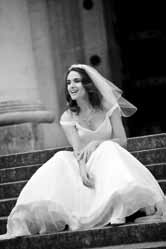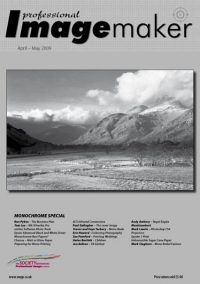articles/Weddings/diaryofafashionshoot-page5
Diary of a Fashion Shoot - part 5 of 1 2 3 4 5 6
by Mark Cleghorn Published 01/04/2009
image 9
The silver reflector adds a near spotlight effect on to the subject when used on a sunny day. Metering is no different than normal, as it is taken only when the reflector is in place, otherwise a dramatically over-exposed image would result
image 10
In this shot I have moved the subject away from the pillar to allow the sun to fall on to the model's back and dress. It forms a natural back-light or rim-light effect, which is perfect for separating the subject from the background. The sunlight needs to be reflected back onto the subject not only to sharpen the ambient light on the face, but also to help with the balance of the light in the overall exposure. Otherwise the edges of the dress around the model would be fully burned out and start to flare back into the lens, which would need time spent in Photoshop to correct the problem.
image 11
When a model is walking either away or towards the camera it is essential, if a reflector is being used to obtain the exposure in open light, that the assistant tracks the reflector at the same pace as the model, to maintain the correct exposure.

'Don't forget to shoot the details Mark' - If I hear that once a day I hear it a million times, if not from the client then from myself. These are quickly shot during the day, just like on a real wedding. A long lens allows me to work quickly, but the lighting needs to come from a slight angle to show more texture; if the light source is over my shoulder the detail on the material will be flat and not three dimensional.
A few minutes' drive from the university building is the National Museum of Wales, our third and final location of the day. It's an awesome building, with huge columns and a location we use often for all kinds of shoots from families to graduations.
The final dresses in the collection have been selected especially for this location, as they seem to lend themselves to the classic setting.The museum has an exquisite light quality at the end of a day, which is enhanced by the overhead and side subtraction of the light by the building itself. The lighting skills I use here are no different from a wedding shoot, as the location lends itself perfectly to a 45-degree lighting pattern, due to the apertures formed by the pillars.
By placing the model slightly backward of the aperture of the pillars, the light is subtracted enough to create a window-type of lighting, the style we all mimic in a studio every day as the pillars give a feather edge to the light and hence specular in its quality ontothe subject. This also helps with any reflection of light off the dress, minimising any burnout of detail. Turning the torso away from the light source, which is so typical of a female portrait pose, can further protect this detail
Please Note:
There is more than one page for this Article.
You are currently on page 5
- Diary of a Fashion Shoot page 1
- Diary of a Fashion Shoot page 2
- Diary of a Fashion Shoot page 3
- Diary of a Fashion Shoot page 4
- Diary of a Fashion Shoot page 5
- Diary of a Fashion Shoot page 6
1st Published 01/04/2009
last update 09/12/2022 14:53:18
More Weddings Articles
There are 0 days to get ready for The Society of Photographers Convention and Trade Show at The Novotel London West, Hammersmith ...
which starts on Wednesday 15th January 2025




